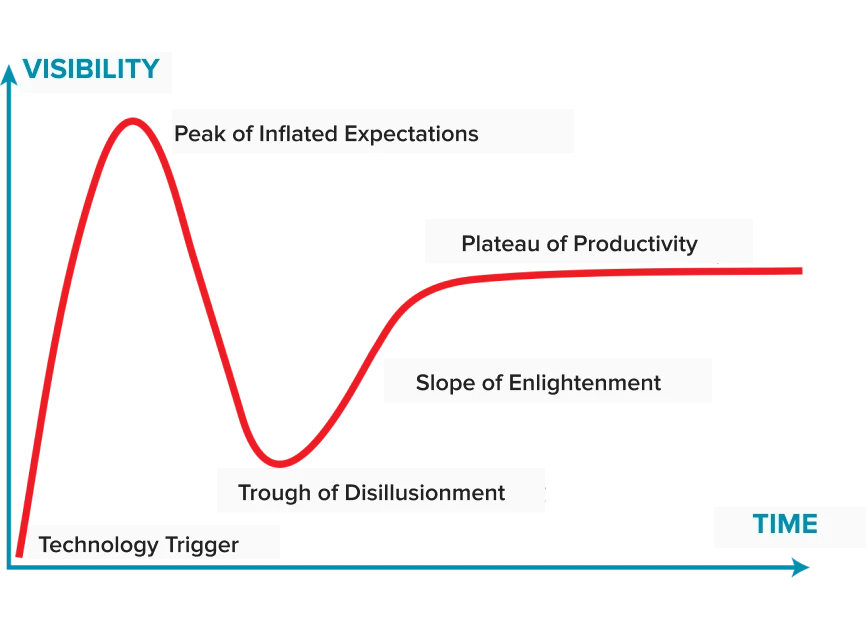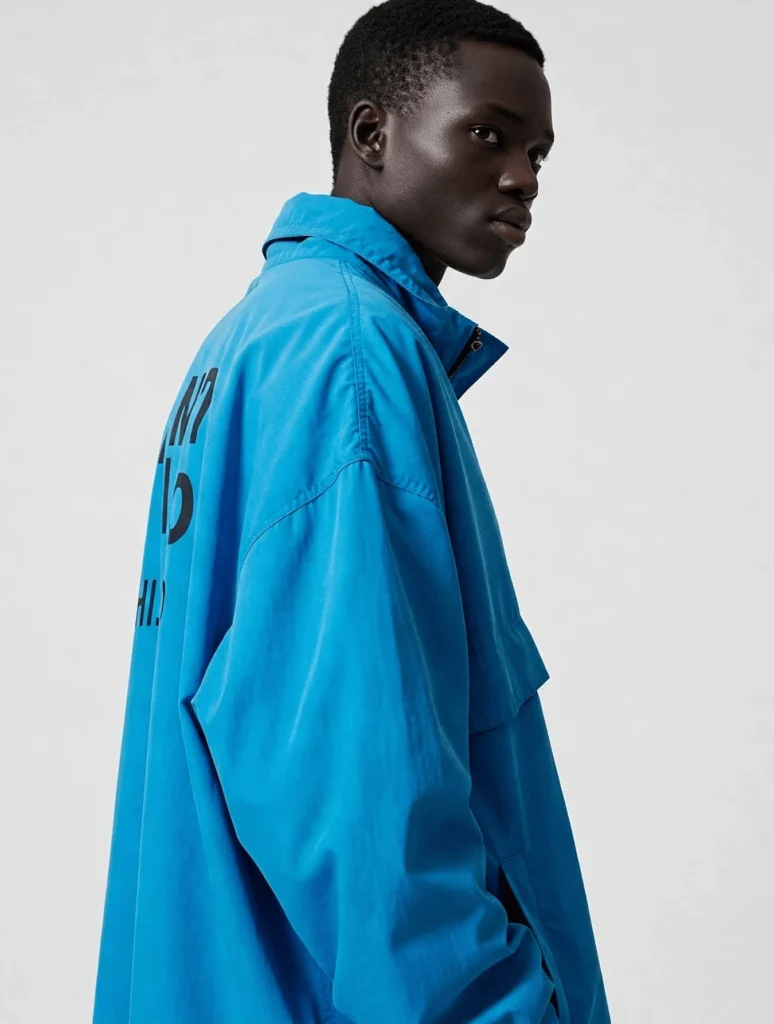I’ve been fascinated with the intersection of technology and creativity since I got the first Macintosh the year it came out. I remember watching the “1984” Apple Super Bowl commercial and recognizing how it represented more than an advertisement—it was a manifesto of technological empowerment. If you don’t know it, please pause and watch, I’m going to come back to this.
In 1984, the Mac made it possible for people to easily work with digital images. From desktop publishing to the internet, digital photography, CGI, and now AI, technology has continuously reshaped creative production. As someone leading a creative production company, I’ve learned that tech adoption isn’t just important—it’s critical to survival.
Early on, I noticed a pattern that I later learned is called the Gartner Hype Cycle. Roughly every seven years, there’s a significant technological advancement that plays out in creative production, just like everywhere else. What’s notable is that the signals and reactions remain largely the same, the only thing that changes is the speed of adoption.

The cycle unfolds in four phases. The initial phase is when a new technology is released and the hype skyrockets. That’s usually when everyone thinks they will be replaced because the promise is endless and the tech seemingly works perfectly. Phase 1 is pretty quickly followed by Phase 2, the “Trough of Disillusionment,” which is where everyone says, “wait, this tech sucks and is not viable. What was I worried about?, this will never catch on.” Then, just when we’re sure it’s all hype, the tech improves a lot (Phase 3 – The Slope of Enlightenment) and suddenly people are finding real value and searching for more ways to use it. Then we settle into Phase 4 where the tech fully matures and is part of our everyday lives.
A client recently asked me, “Where are we on the curve now, and what does it mean for the industry?” For many use cases, I believe we’re in the beginning of Phase 3, where the technology is advancing rapidly and becoming really good, really fast. Even in areas where the technology is still emerging, the rate of innovation is still incredible.
At Industrial Color, we’re actively using AI for numerous clients, constantly iterating on new ways to expand our production capabilities, develop our own products, and improve our internal processes.
It’s evident that AI applied to creative production creates a compounding effect. For instance, we can now apply AI to stills and photogrammetry to rapidly generate poseable 3D content, providing marketers with hyper-optimized content at a fraction of the traditional cost. Similar applications are emerging across various formats—still images, video, music, copywriting, design, layout, 3D modeling, and beyond— fundamentally expanding what production and downstream teams can achieve.


Beyond generating entirely new content, AI creates numerous production efficiencies, informing content awareness and decision-making. A few weeks ago, OpenAI just released OpenAI o1 that “thinks” before acting. This self-check process will make things very interesting and I have no doubt that another advancement is imminent.
2024 was a transformative year for Industrial Color, largely driven by the integration of AI into almost every aspect of the company. The tangible impact of this evolution can be seen in three key areas: improving internal processes, enhancing our tech platform, and – most significantly – expanding the content we create for our clients.
Internal processes
AI tool adoption has enabled us to discover efficiencies and implement incremental changes that cumulatively make a substantial difference. It has also opened the door for our teams to approach projects in a more comprehensive way by leveraging generative tools, historical data, and refined workflows.
One example is creative ideation, concepting, and storyboarding. Our teams can explore different ideas using tools like Midjourney, Runway ML, and now Sora, modeling layouts in both 2D and 3D, still and motion. It’s pretty remarkable—we can push ideas in countless directions, iterate on concepts within minutes, and expand our capacity to conceptualize and communicate singular ideas to our clients. We’re also leveraging AI through data. Like any company, we have troves of data and are finding insights into optimal practices, content formats, and workflow sequences by exploring that data with different models.
Content for clients
While the technology remains nascent in some areas, we are consistently discovering ways to leverage leading and emerging tools to produce production-quality AI-generated content, from product packaging to motion campaigns. Lately, we’re producing more AI castings for clients and developing campaign content that feels like a traditional high-production shoot but contains elements that are incredibly hard or cost-prohibitive to capture—like hundreds of exotic flowers actively blooming or scenic shots in inaccessible locations.
What I find most exciting are the storytelling abilities this technology unlocks. Creatives and brands can stretch their imaginations to the limit, play with new styles, explore different compositions, and create narratives that were not previously possible or practical before. I think we’re just scratching the surface of technology’s potential.
There’s also a huge opportunity to breathe new life into existing assets. By training AI models on brand archive content, we can create new content with the same production value as traditional methods while maintaining the brand’s singular aesthetic style.
The critical element when creating high-quality content is defining the correct order of operations, pairing the right techniques, and identifying where to apply traditional processes and where to leverage AI. We’ve found that our decades of collective experience make the crucial difference between producing something exceptional and something that feels artificial. We are also using platforms like ComfyUI to combine different AI tools and create custom workflows optimized for specific content.

Building new technology
Since launching Globaledit in 2003, we’ve been developing in-house technology. Today, we’re reimagining what it means to be a production software company. This year, we developed our first set of AI tools, starting with object and facial recognition technologies that can train on specific faces or broad datasets, making items and talent instantly searchable within entire libraries. These features are a game changer for almost any brand, but particularly the entertainment, sports and live event markets.
Looking forward, there are clear use cases for post production, marketing, PR, and social teams, where AI can not only automate manual processes, but aid in curation, recommendations, and other time consuming tasks. We see pure production and content management platforms converging like never before and are actively developing a suite of AI enabled products that will deliver totally new capabilities and vastly improve time to market for our brand clients.
Importantly, AI doesn’t replace creativity—it amplifies it. Like the early Macintosh democratizing design tools, AI provides creative minds with unprecedented capabilities to explore and iterate rapidly. We’re not diminishing original thought; we’re accelerating it.
Our teams are using these tools to propel ideas further, deliver content faster, and transform initial concepts into unexpected, powerful experiences. It’s not about AI replacing human creativity, but about giving creatives more powerful tools to express their vision.
We’re standing at the threshold of another technological revolution. And just like the “1984” commercial promised—we’re here to break through the status quo and do things differently.
It’s a brave new world, again.
